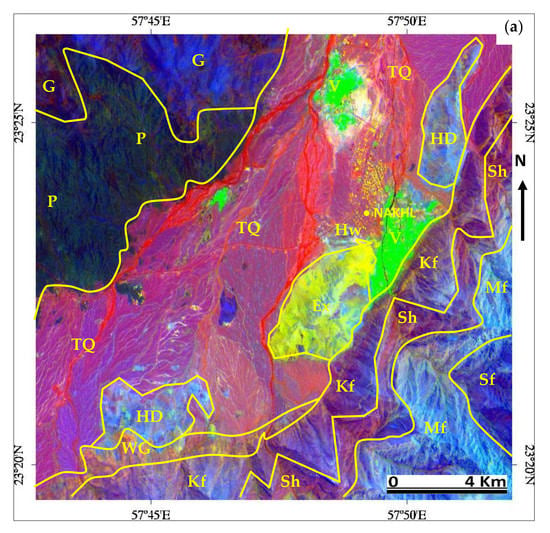Spectral Signature Characterization and Remote Mapping of Oman Exotic Limestones for Industrial Rock Resource Assessment
Abstract
:1. Introduction
2. The Exotic Limestone of Oman
3. Materials and Methods
3.1. Image Data-Set
3.2. Characterization of Spectral Signature of the Exotic Limestone
3.3. Image Elaboration Methodologies
4. Results
Field and Laboratory Studies
5. Discussion
6. Conclusions
Acknowledgments
Author Contributions
Conflicts of Interest
References
- Smith, M.R. (Ed.) Stone: Building stone, rock fill and armourstone in construction. In Geological Society Engineering Geology; Special Publication No. 16; Geological Society: London, UK, 1999. [Google Scholar]
- Nasir, S.; Rajendran, S.; El Ghali, M.; Hosni, T.; Elzebdeh, K.; Al-Rawas, G. Geotechnical Assessment of Dimension stone Resources in Oman. Int. J. Chem. Environ. Biol. Sci. 2015, 3, 439–443. [Google Scholar]
- Searle, M.P.; Graham, G.M. “Oman Exotics”—Oceanic carbonate build-ups associated with the early stages of continental rifting. Geology 1982, 10, 43–49. [Google Scholar] [CrossRef]
- Mwaniki, M.W.; Moeller, M.S.; Schellmann, G. A comparison of Landsat 8 (OLI) and Landsat 7 (ETM+) in mapping geology and visualising lineaments: A case study of central region Kenya. Arch. Photogramm. Remote Sens. Spat. Inf. Sci. 2015, XL-7/W3, 897–903. [Google Scholar] [CrossRef]
- Van der Meer, F.D.M.; Van der Werff, F.D.H.; Van Ruitenbeek, F.J.A.; Hecker, C.A.; Bakker, W.H.; Noomen, M.F.; Van der Meijde, M.; Carranza, E.J.M.; De Smeth, J.B.; Woldai, T. Multi- and hyperspectral geologic remote sensing: A review. Int. J. Appl. Earth Obs. Geoinf. 2012, 14, 112–128. [Google Scholar] [CrossRef]
- Rajendran, S.; Nasir, S.; Kusky, T.M.; Al-Khirbash, S. Remote sensing based approach for mapping of CO2 sequestered regions in Semail ophiolite massifs of the Sultanate of Oman. Earth Sci. Rev. 2014, 135, 122–140. [Google Scholar] [CrossRef]
- Bustos, E.; Báez, W.A.; Norini, G.; Chiodi, A.L.; Groppelli, G.; Arnosio, J.M. Using optical imagery data for lithological mapping of composite volcanoes in high arid Puna Plateau. Tuzgle volcano case study. Rev. Asoc. Geol. Argent. 2017, 74, 357–372. [Google Scholar]
- Harding, D.J.; Wirth, K.R.; Bird, J.M. Spectral mapping of Alaskan ophiolites using Landsat thematic mapper data. Remote Sens. Environ. 1989, 28, 219–232. [Google Scholar] [CrossRef]
- Öztan, N.S.; Süzen, M.L. Mapping evaporate minerals by ASTER. Int. J. Remote Sens. 2011, 32, 1651–1673. [Google Scholar] [CrossRef]
- Amer, R.; Kusky, T.M.; Ghulam, A. Lithological mapping in the central eastern desert of Egypt using ASTER data. J. Afr. Earth Sci. 2010, 56, 75–82. [Google Scholar] [CrossRef]
- Yuan, Y.; Kusky, T.M.; Rajendran, S. Tertiary and Quaternary Marine Terraces and Planation Surfaces of Northern Oman: Interaction of Flexural Bulge Migration Associated with the Arabian-Eurasian Collision and Eustatic Sea Level Changes. J. Earth Sci. 2016, 27, 955–970. [Google Scholar] [CrossRef]
- Abdelkareem, M.; El-Baz, F. Characterizing hydrothermal alteration zones in Hamama area in the central Eastern Desert of Egypt by remotely sensed data. Geocarto Int. 2017, 1–9. [Google Scholar] [CrossRef]
- Eslami, A.; Ghaderi, M.; Rajendran, S.; Pour, A.B.; Hashim, M. Integration of ASTER and Landsat TM remote sensing data for chromite prospecting and lithological mapping in Neyriz ophiolite zone, south Iran. Resour. Geol. 2015, 65, 375–388. [Google Scholar] [CrossRef]
- Rothery, D.A. Decorrelation stretching an aid to image interpretation. Int. J. Remote Sens. 1987, 8, 1253–1254. [Google Scholar] [CrossRef]
- Gillespie, A.R.; Kahle, A.B.; Walker, R.E. Color enhancement of highly correlated images. I. Decorrelation and HSI contrast stretches. Remote Sens. Environ. 1986, 20, 209–735. [Google Scholar] [CrossRef]
- Pournamdari, M.; Hashim, M. Detection of chromite bearing mineralized zones in Abdasht ophiolite complex using ASTER and ETM+ remote sensing data. Arabian J. Geosci. 2014, 7, 1973–1983. [Google Scholar] [CrossRef]
- Graham, G.M. Structure and Sedimentology of the Hawasina Window, Oman Mountains. Ph.D. Thesis, Open University, Milton Keynes, UK, 1980; p. 422. [Google Scholar]
- Searle, M.P. The Metamorphic Sheet and Underlying Volcanic Rocks Beneath the Semail Ophiolite in the Northern Oman Mountains of Arabia. Ph.D. Thesis, Open University, Milton Keynes, UK, 1980. [Google Scholar]
- Searle, M.P.; Malpas, J. Structure and metamorphism of rocks beneath the Semail ophiolite of Oman and their significance in ophiolite obduction: Royal Society of Edinburgh. Transactions 1980, 71, 213–228. [Google Scholar] [CrossRef]
- KSEPL. Geological Map of the Oman Mountains (Scale 1:500,000); KSEPL: Directorate General of Minerals, Sultanate of Oman, 1974. [Google Scholar]
- San, B.T.; Suzen, M.L. Evaluation of different atmospheric correction algorithms for EO-1 Hyperion imagery. Int. Arch. Photogramm. Remote Sens. Spat. Inf. Sci. 2010, XXXVII, 392–397. [Google Scholar]
- Rajendran, S.; Nasir, S. ASTER spectral sensitivity of carbonate rocks—Study in Sultanate of Oman. Adv. Space Res. 2014, 53, 656–673. [Google Scholar] [CrossRef]
- Mars, J.C.; Rowan, L.C. Spectral assessment of new ASTER SWIR surface reflectance data products for spectroscopic mapping of rocks and minerals. Remote Sens. Environ. 2010, 114, 2011–2025. [Google Scholar] [CrossRef]
- Baldridge, A.M.; Hook, S.J.; Grove, C.I.; Rivera, G. The ASTER spectral library version 2.0. Remote Sens. Environ. 2009, 113, 711–715. [Google Scholar] [CrossRef]
- Ministry of Petroleum and Minerals. Geological Map, Oman (1: 100,000). NAKHL—Sheet NF40-3E; Ministry of Petroleum and Minerals: Directorate General of Minerals, Sultanate of Oman, 1986. [Google Scholar]
- Baiocchi, V.; Brigante, R.; Dominici, D.; Milone, M.V.; Mormile, M.; Radicioni, F. Automatic three-dimensional features extraction: The case study of L’Aquila for collapse identification after April 06, 2009 earthquake. Eur. J. Remote Sens. 2014, 47, 413–435. [Google Scholar] [CrossRef]
- Chander, G.; Markham, B.L.; Helder, D.L. Summary of current radiometric calibration coefficients for Landsat MSS, TM, ETM+, and EO-1 ALI sensors. Remote Sens. Environ. 2009, 113, 893–903. [Google Scholar] [CrossRef]
- Vermote, E.F.; Tanre, D.; Deuzé, J.L.; Herman, M.; Morcrette, J.J. Second simulation of the satellite signal in the solar spectrum, 6S: An overview. IEEE Trans. Geosci. Remote Sens. 1997, 35, 675–686. [Google Scholar] [CrossRef]
- Tanre, D.; Deroo, C.; Duhaut, P.; Herman, M.; Morcrette, J.J.; Perbos, J.; Deschamps, P.Y. Technical note description of a computer code to simulate the satellite signal in the solar spectrum—The 5S code. Int. J. Remote Sens. 1990, 11, 659–668. [Google Scholar] [CrossRef]
- Berk, A.; Anderson, G.P.; Acharya, P.K.; Chetwynd, J.H.; Bernstein, L.S.; Shettle, E.P. MODTRAN 4 User’s Manual; Air Force Research Laboratory, Space Vehicles Directorate, Air Force Material Command: Hanscom AFB, MA, USA, 1999; pp. 1731–3010. [Google Scholar]
- Clark, R.N. Spectroscopy of rock and minerals and principles of spectroscopy. In Remote Sensing for the Earth Sciences: Manual of Remote Sensing, 3rd ed.; Rencz, A.N., Ed.; John Wiley & Sons: New York, NY, USA, 1999; Volume 3, pp. 3–58. [Google Scholar]
- Gaffey, S.J. Reflectance spectroscopy in the visible and near infrared (0.35–2.55 microns): Applications in carbonate petrology. Geology 1985, 13, 270–273. [Google Scholar] [CrossRef]
- Gaffey, S.J. Spectral reflectance of carbonate minerals in the visible and near infrared (0.35–2.55 microns): Calcite, aragonite, and dolomite. Am. Mineral. 1986, 71, 151–162. [Google Scholar]
- Gaffey, S.J. Spectral reflectance of carbonate minerals in the visible and near infrared (0.35–2.55 microns): Anhydrous carbonate minerals. J. Geophys. Res. 1987, 92, 1429–1440. [Google Scholar] [CrossRef]
- Abrams, M.J.; Rothery, D.A.; Pontual, A. Mapping in the Oman ophiolite using enhanced Landsat thematic mapper images. Tectonophysics 1988, 151, 387–401. [Google Scholar] [CrossRef]
- Rajendran, S.; Nasir, S. ASTER mapping of limestone formations and study of caves, springs and depressions in parts of Sultanate of Oman. Environ. Earth Sci. 2014, 71, 133–146. [Google Scholar] [CrossRef]
- Bedini, E. Mineral mapping in the Kap Simpson complex, central East Greenland, using HyMap and ASTER remote sensing data. Adv. Space Res. 2011, 47, 60–73. [Google Scholar] [CrossRef]
- Zhang, X.; Pazner, M.; Duke, N. Lithologic and mineral information extraction for gold exploration using ASTER data in the south Chocolate Mountains (California). Photogramm. Remote Sens. 2007, 62, 271–282. [Google Scholar] [CrossRef]
- Richards, J.A.; Jia, X. Remote Sensing Digital Image Analysis; Springer: Berlin/Heidelberg, Germany, 2006. [Google Scholar]
- Jia, X.; Richards, A. Efficient maximum likelihood classification for imaging spectrometer data sets. IEEE Trans. Geosci. Remote Sens. 1994, 32, 274–281. [Google Scholar]
- El Janati, M.; Soulaimani, A.; Admou, H.; Youbi, N.; Hafid, A.; Hefferan, K.P. Application of ASTER remote sensing data to geological mapping of basement domains in arid regions: A case study from the central Anti-Atlas, Iguerda inlier, Morocco. Arab. J. Geosci. 2014, 7, 2407–2422. [Google Scholar] [CrossRef]
- Yuhas, R.H.; Goetz, A.F.H.; Boardman, J.W. Discrimination among semi-arid landscape endmembers using the spectral angle mapper (SAM) algorithm. JPL Publ. 1992, 4, 147–149. [Google Scholar]
- Kruse, F.A.; Lefkoff, A.B.; Boardman, J.B.; Heidebreicht, K.B.; Shapiro, A.T.; Barloon, P.J. The spectral image processing system (SIPS)—Interactive visualization and analysis of imaging spectrometer data. Remote Sens. Environ. 1993, 44, 145–163. [Google Scholar] [CrossRef]
- Xu, Z.; Zhao, H. A new spectral unmixing algorithm based on spectral information divergence. Proc. SPIE 2008, 7127, 712–726. [Google Scholar]
- Fukunaga, K. Introduction to Statistical Pattern Recognition, 2nd ed.; Academic Press: New York, NY, USA, 1990. [Google Scholar]
- Jensen, J.R. Introductory Digital Image Processing: A Remote Sensing Perspective, 2nd ed.; Prentice Hall Series in Geographic Information Science; Prentice Hall: Upper Saddle River, NJ, USA, 1996. [Google Scholar]
- Bock, M.; Xofis, P.; Mitchley, J.; Rossner, G.; Wissen, M. Object-oriented methods for habitat mapping at multiple scales—Case studies from Northern Germany and Wye Downs, UK. J. Nat. Conserv. 2005, 13, 75–89. [Google Scholar] [CrossRef]
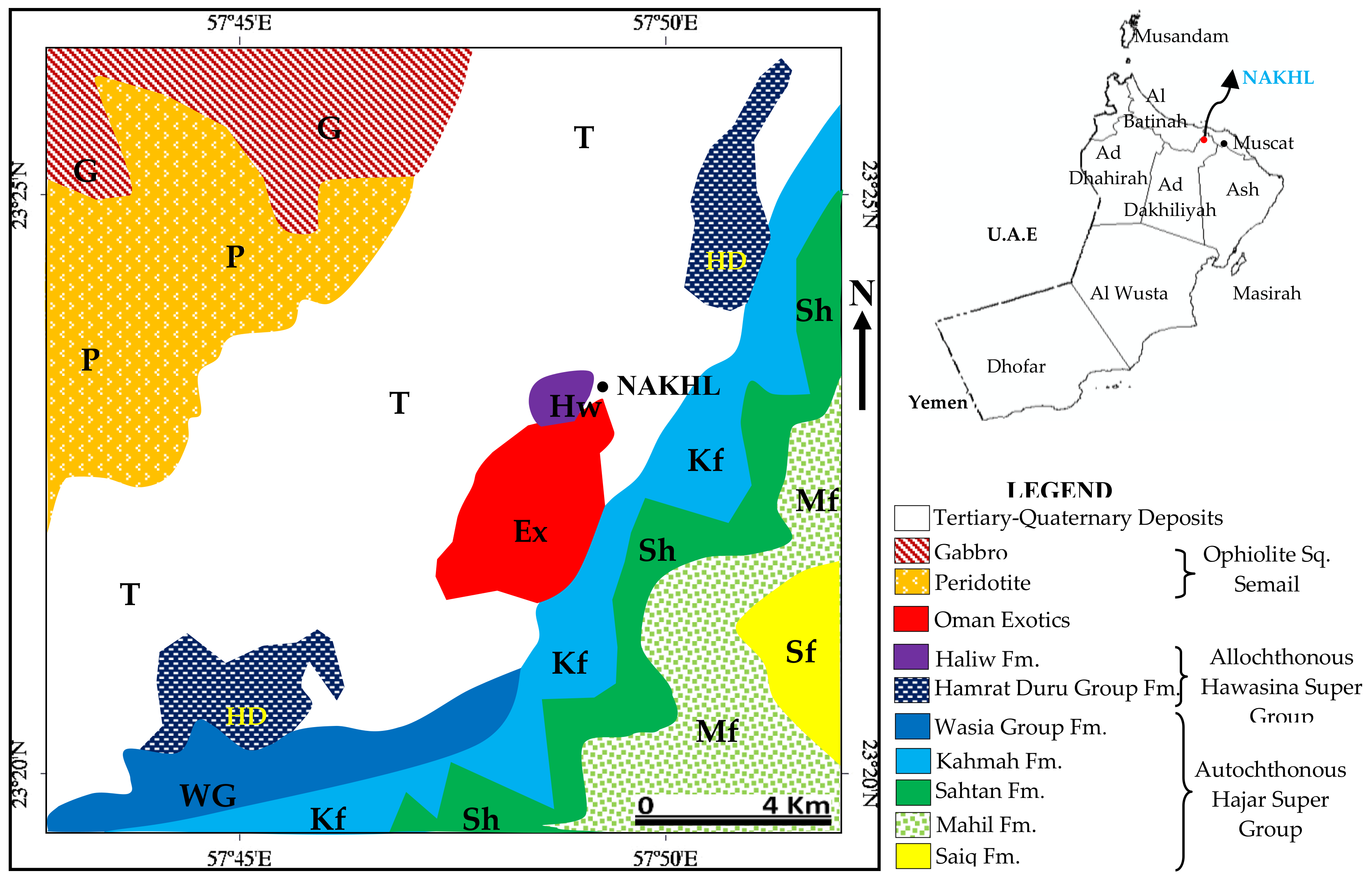

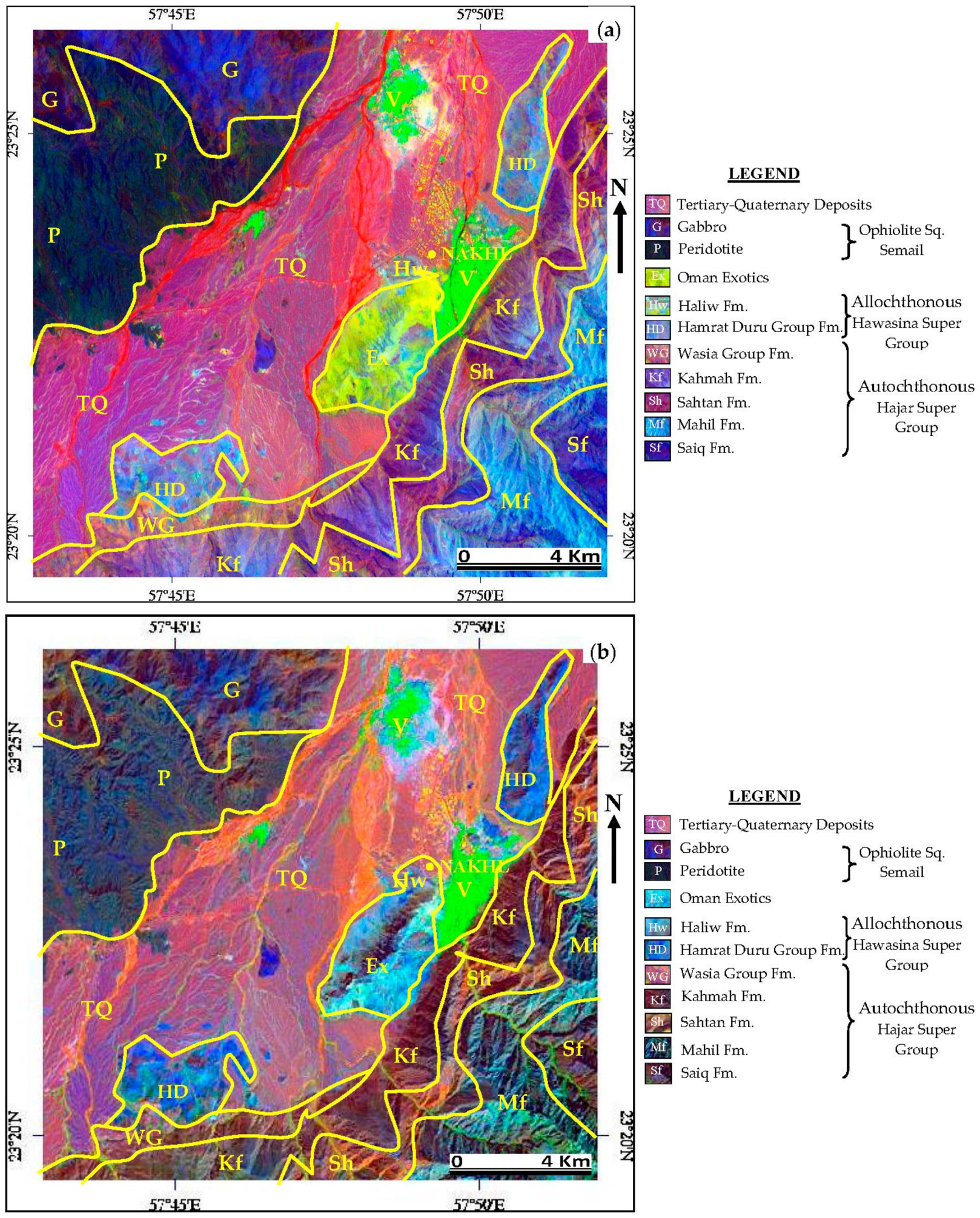
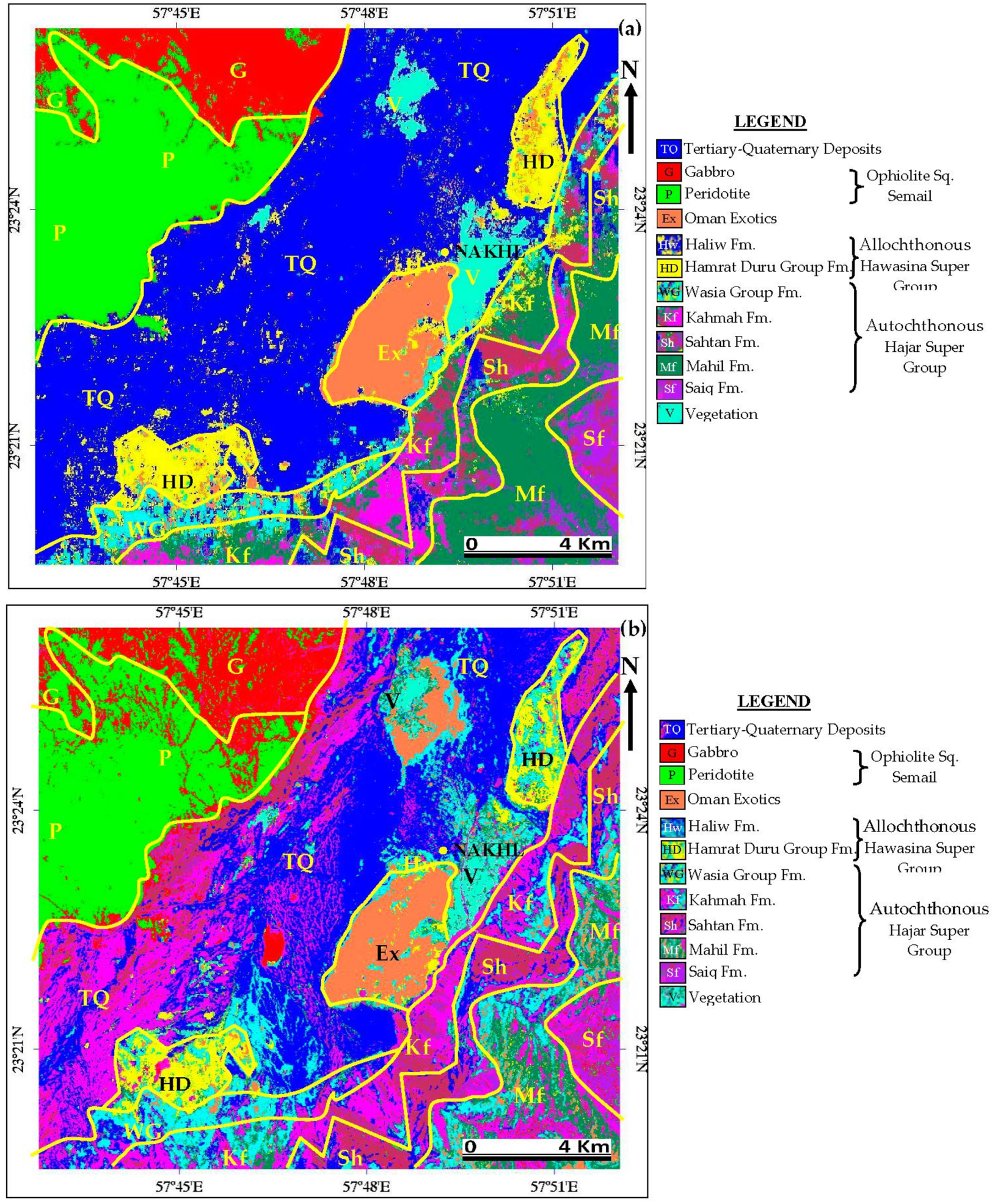

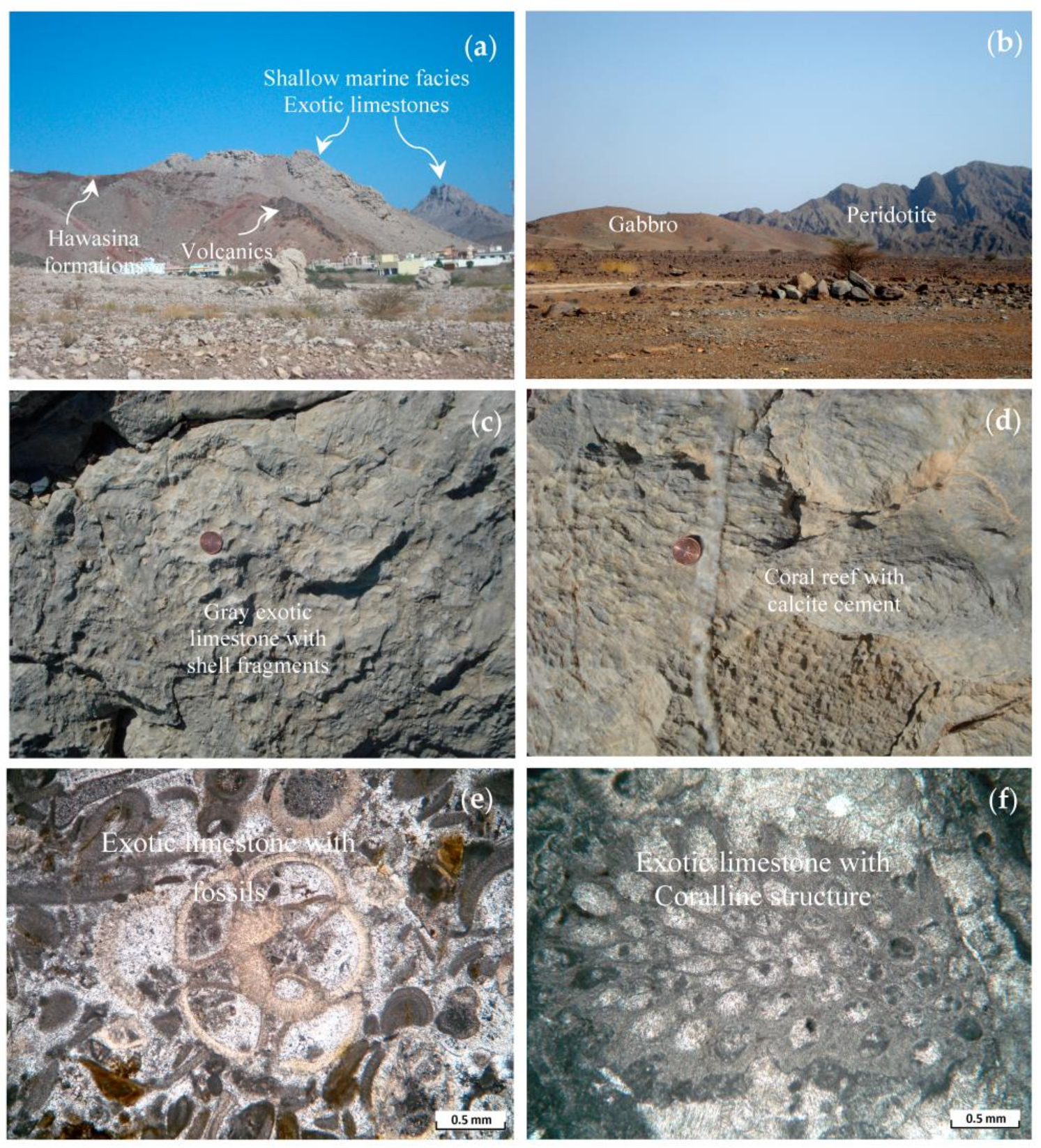
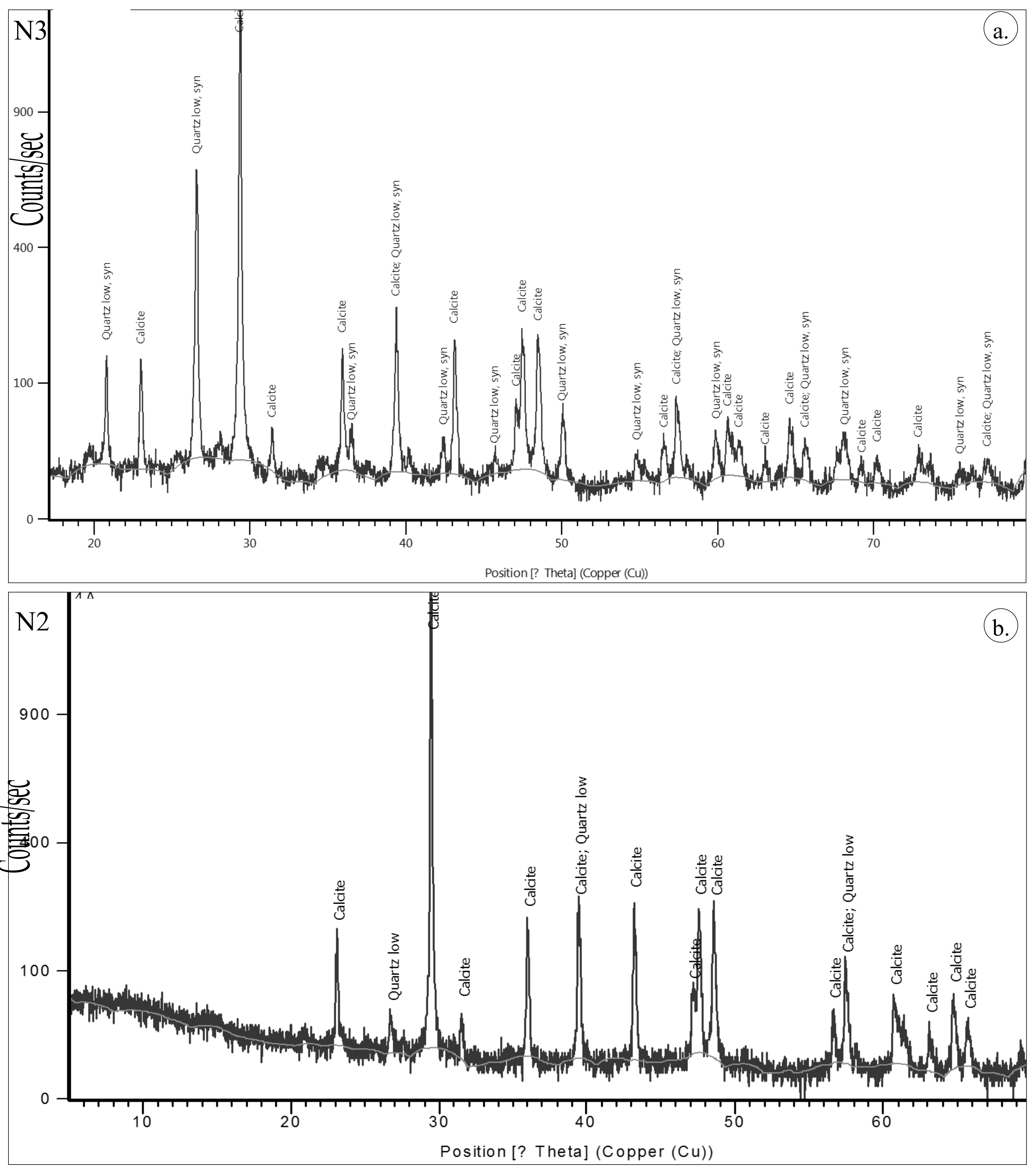
| Sensor Characters | Landsat 7 (ETM+) | VNIR | ASTER SWIR | TIR |
|---|---|---|---|---|
| Spectral bands with range (µm) | Band1 0.45–0.52 | Band 01 0.52–0.60 Nadir looking | Band 04 1.6–1.7 | Band 10 8.125–8.475 |
| Band2 0.52–0.60 | Band 02 0.63–0.69 Nadir looking | Band 05 2.145–2.185 | Band 11 8.475–8.825 | |
| Band3 0.63–0.69 | Band 03N 0.76–0.86 Nadir looking | Band 06 2.185–2.225 | Band 12 8.925–9.275 | |
| Band4 0.77–0.90 | Band 03B 0.76–0.86 Backward looking | Band 07 2.235–2.285 | Band 13 10.25–10.95 | |
| Band5 1.55–1.75 | Band 08 2.295–2.365 | Band 14 10.95–11.65 | ||
| Band6 10.40-12.50 * | Band 09 2.36–2.43 | |||
| Band7 2.09–2.35 | ||||
| Band8 0.52-0.90 ** | ||||
| Spatial Resolution (m) | 30 | 15 | 30 | 90 |
| Swath width (km) | 180 | 60 | 60 | 60 |
| Radiometric Resolution (bits) | 8 | 8 | 8 | 12 |
| Cross Track Pointing | ±318 km (±24 deg) | ±116 km (±8.55 deg) | ±116 km (±8.55 deg) |
| Carbonate Band | Calcite * Absorption (µm) | Exotic Limestones Absorption (µm) | Dolomite * Absorption (µm) | Dolostones Absorption (µm) |
|---|---|---|---|---|
| 1 | 2.530–2.541 | 2.491 | 2.503–2.518 | 2.472 |
| 2 | 2.333–2.340 | 2.341 | 2.312–2.322 | 2.328 |
| 3 | 2.254–2.272 | - | 2.234–2.248 | - |
| 4 | 2.167–2.179 | 2.154 | 2.150–2.170 | 2.144 |
| 5 | 1.974–1.995 | 1.992 | 1.971–1.979 | 1.981 |
| 6 | 1.871–1.885 | 1.875 | 1.853–1.882 | 1.863 |
| 7 | 1.753–1.885 | 1.752 | 1.735–1.740 | - |
| Class | G | P | HD | WG | Ka | Sa | Ma | Sq | Ex | TQ | V | Total | User’s Accuracy |
|---|---|---|---|---|---|---|---|---|---|---|---|---|---|
| (a) Confusion matrix of MLC algorithm | |||||||||||||
| Unclassified | 0.00 | 0.00 | 0.00 | 0.00 | 0.00 | 0.00 | 0.00 | 0.00 | 0.00 | 0.00 | 0.00 | 0.00 | |
| G | 100.00 | 0.00 | 0.00 | 0.00 | 0.00 | 0.00 | 0.00 | 0.00 | 0.00 | 0.00 | 0.00 | 7.95 | 100.00 |
| P | 0.00 | 100.00 | 0.00 | 0.00 | 0.00 | 0.00 | 0.00 | 0.00 | 0.00 | 0.00 | 0.00 | 12.61 | 100.00 |
| HD | 0.00 | 0.00 | 100.00 | 0.00 | 0.00 | 0.00 | 0.00 | 0.00 | 0.00 | 0.18 | 0.00 | 9.27 | 89.89 |
| WG | 0.00 | 0.00 | 0.00 | 100.00 | 0.65 | 0.00 | 0.00 | 0.00 | 0.00 | 2.12 | 0.00 | 6.60 | 98.40 |
| Ka | 0.00 | 0.00 | 0.00 | 0.00 | 99.35 | 0.00 | 0.00 | 0.00 | 0.00 | 0.23 | 0.00 | 4.33 | 100.00 |
| Sa | 0.00 | 0.00 | 0.00 | 0.00 | 0.00 | 100.00 | 0.00 | 0.00 | 0.00 | 0.00 | 0.00 | 3.26 | 100.00 |
| Ma | 0.00 | 0.00 | 0.00 | 0.00 | 0.00 | 0.00 | 98.92 | 0.00 | 0.00 | 0.00 | 0.00 | 5.10 | 100.00 |
| Sq | 0.00 | 0.00 | 0.00 | 0.00 | 0.00 | 0.00 | 0.00 | 100.00 | 0.00 | 0.00 | 0.00 | 10.28 | 98.49 |
| Ex | 0.00 | 0.00 | 0.00 | 0.00 | 0.00 | 0.00 | 1.08 | 0.00 | 100.00 | 0.00 | 0.00 | 3.68 | 100.00 |
| TQ | 0.00 | 0.00 | 0.00 | 0.00 | 0.00 | 0.00 | 0.00 | 0.00 | 0.00 | 97.46 | 0.00 | 29.37 | 99.40 |
| V | 0.00 | 0.00 | 0.00 | 0.00 | 0.00 | 0.00 | 0.00 | 0.00 | 0.00 | 0.00 | 100.00 | 7.56 | 100.00 |
| Total | 100.00 | 100.00 | 100.00 | 100.00 | 100.00 | 100.00 | 100.00 | 100.00 | 100.00 | 100.00 | 100.00 | 100.00 | |
| Producer’s accuracy | 100.00 | 100.00 | 100.00 | 99.35 | 100.00 | 98.92 | 100.00 | 100.00 | 97.46 | 100.00 | 100.00 | ||
| Overall accuracy = 99.15%; Kappa coefficient = 0.99 | |||||||||||||
| (b) Confusion matrix of SAM algorithm | |||||||||||||
| Unclassified | 0.00 | 0.00 | 0.00 | 0.00 | 0.00 | 0.00 | 0.00 | 0.00 | 0.00 | 0.00 | 2.21 | 0.17 | |
| G | 95.28 | 2.31 | 1.06 | 2.11 | 0.00 | 0.43 | 1.89 | 0.00 | 8.05 | 0.00 | 0.00 | 8.49 | 89.20 |
| P | 3.32 | 97.69 | 0.00 | 0.00 | 0.00 | 0.00 | 0.27 | 0.00 | 1.53 | 0.00 | 0.00 | 12.65 | 97.37 |
| HD | 0.17 | 0.00 | 64.40 | 0.47 | 11.00 | 5.11 | 5.12 | 0.00 | 0.00 | 0.05 | 0.37 | 6.92 | 59.71 |
| WG | 0.00 | 0.00 | 0.15 | 77.05 | 11.33 | 0.00 | 0.00 | 13.51 | 0.00 | 3.96 | 0.00 | 7.65 | 44.66 |
| Ka | 0.00 | 0.00 | 2.87 | 6.09 | 59.55 | 6.81 | 0.27 | 2.84 | 0.00 | 6.55 | 0.55 | 5.72 | 41.21 |
| Sa | 0.35 | 0.00 | 5.13 | 3.75 | 8.74 | 66.81 | 4.85 | 11.08 | 16.09 | 0.00 | 0.55 | 5.29 | 65.15 |
| Ma | 0.52 | 0.00 | 19.00 | 0.00 | 0.00 | 0.85 | 81.13 | 0.00 | 11.49 | 0.00 | 0.00 | 6.42 | 65.75 |
| Sq | 0.00 | 0.00 | 0.30 | 5.62 | 8.41 | 2.98 | 0.00 | 64.59 | 0.38 | 6.18 | 10.11 | 10.10 | 65.46 |
| Ex | 0.35 | 0.00 | 0.15 | 0.00 | 0.00 | 17.02 | 6.47 | 2.57 | 62.45 | 0.00 | 0.00 | 3.46 | 93.92 |
| TQ | 0.00 | 0.00 | 6.94 | 4.92 | 0.97 | 0.00 | 0.00 | 5.41 | 0.00 | 83.26 | 1.29 | 26.71 | 85.74 |
| V | 0.00 | 0.00 | 0.00 | 0.00 | 0.00 | 0.00 | 0.00 | 0.00 | 0.00 | 0.00 | 84.93 | 6.42 | 100.00 |
| Total | 100.00 | 100.00 | 100.00 | 100.00 | 100.00 | 100.00 | 100.00 | 100.00 | 100.00 | 100.00 | 100.00 | 100.00 | |
| Producer’s accuracy | 95.28 | 97.69 | 77.05 | 59.55 | 66.81 | 81.13 | 64.59 | 62.45 | 83.26 | 64.40 | 84.93 | ||
| Overall accuracy = 79.71%; Kappa coefficient = 0.76 | |||||||||||||
| (c) Confusion matrix of SID algorithm | |||||||||||||
| Unclassified | 0.00 | 0.00 | 0.00 | 0.00 | 0.00 | 0.00 | 0.00 | 0.00 | 0.00 | 0.00 | 0.00 | 0.00 | |
| G | 94.06 | 1.32 | 0.15 | 0.00 | 0.00 | 0.00 | 2.16 | 0.81 | 12.64 | 0.00 | 0.00 | 8.31 | 89.97 |
| P | 1.92 | 98.68 | 0.00 | 0.00 | 0.00 | 0.00 | 0.27 | 0.00 | 2.30 | 0.00 | 0.00 | 12.70 | 98.03 |
| HD | 0.00 | 0.00 | 62.14 | 0.47 | 10.36 | 12.77 | 0.54 | 0.14 | 0.00 | 0.00 | 0.18 | 6.67 | 58.23 |
| WG | 0.00 | 0.00 | 0.00 | 75.41 | 19.74 | 0.00 | 0.00 | 5.81 | 0.00 | 5.86 | 0.00 | 7.68 | 34.33 |
| Ka | 0.00 | 0.00 | 0.30 | 13.58 | 59.55 | 0.00 | 0.00 | 10.68 | 0.00 | 9.50 | 1.29 | 7.45 | 33.47 |
| Sa | 0.35 | 0.00 | 19.31 | 7.49 | 5.18 | 71.91 | 2.96 | 15.41 | 9.96 | 0.00 | 1.29 | 7.01 | 76.67 |
| Ma | 0.00 | 0.00 | 8.45 | 0.00 | 0.00 | 2.13 | 86.79 | 0.00 | 14.18 | 0.00 | 0.00 | 5.83 | 84.57 |
| Sq | 0.00 | 0.00 | 0.30 | 1.41 | 4.85 | 3.83 | 0.00 | 62.97 | 0.00 | 0.18 | 9.01 | 7.65 | 62.60 |
| Ex | 3.67 | 0.00 | 2.41 | 0.00 | 0.00 | 9.36 | 7.28 | 1.08 | 60.92 | 0.00 | 0.18 | 3.53 | 95.82 |
| TQ | 0.00 | 0.00 | 6.94 | 1.64 | 0.32 | 0.00 | 0.00 | 3.11 | 0.00 | 84.46 | 0.55 | 26.56 | 85.83 |
| V | 0.00 | 0.00 | 0.00 | 0.00 | 0.00 | 0.00 | 0.00 | 0.00 | 0.00 | 0.00 | 87.50 | 6.61 | 100.00 |
| Total | 100.00 | 100.00 | 100.00 | 100.00 | 100.00 | 100.00 | 100.00 | 100.00 | 100.00 | 100.00 | 100.00 | 100.00 | |
| Producer’s accuracy | 94.06 | 98.68 | 75.41 | 59.55 | 71.91 | 86.79 | 62.97 | 60.92 | 84.46 | 62.14 | 87.50 | ||
| Overall accuracy = 80.23%; Kappa coefficient = 0.77 | |||||||||||||
© 2018 by the authors. Licensee MDPI, Basel, Switzerland. This article is an open access article distributed under the terms and conditions of the Creative Commons Attribution (CC BY) license (http://creativecommons.org/licenses/by/4.0/).
Share and Cite
Rajendran, S.; Nasir, S.; El-Ghali, M.A.K.; Alzebdah, K.; Salim Al-Rajhi, A.; Al-Battashi, M. Spectral Signature Characterization and Remote Mapping of Oman Exotic Limestones for Industrial Rock Resource Assessment. Geosciences 2018, 8, 145. https://doi.org/10.3390/geosciences8040145
Rajendran S, Nasir S, El-Ghali MAK, Alzebdah K, Salim Al-Rajhi A, Al-Battashi M. Spectral Signature Characterization and Remote Mapping of Oman Exotic Limestones for Industrial Rock Resource Assessment. Geosciences. 2018; 8(4):145. https://doi.org/10.3390/geosciences8040145
Chicago/Turabian StyleRajendran, Sankaran, Sobhi Nasir, Mohammed A. K. El-Ghali, Khaled Alzebdah, Ali Salim Al-Rajhi, and Mohammed Al-Battashi. 2018. "Spectral Signature Characterization and Remote Mapping of Oman Exotic Limestones for Industrial Rock Resource Assessment" Geosciences 8, no. 4: 145. https://doi.org/10.3390/geosciences8040145




